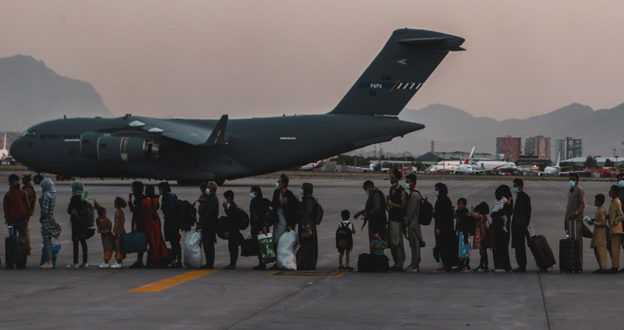Since the hardline Islamist Taliban movement gained control of Afghanistan on August 15, about 90,000 Afghans and foreigners have departed the country via the US-led airlift.As thousands of people scramble to reach a dwindling number of evacuation aircraft, Western governments cautioned their citizens to leave the immediate vicinity of Kabul airport due to a terrorist threat.
Since the hardline Islamist Taliban movement gained control of Afghanistan on August 15, about 90,000 Afghans and foreigners have departed the country via the US-led airlift.
Huge crowds have gathered at and around the airport, with some foreign nations cancelling flights ahead of President Joe Biden’s deadline of Tuesday to stop the evacuations and withdraw the US forces in charge.Biden and his aides highlighted a “acute” terrorist danger from the Islamic State’s regional division as one reason for the strict deadline this week. On Thursday, the US administration and its allies upped the stakes even higher by issuing a series of synchronised and precise advisories advising individuals to avoid the airport.The US State Department advised everyone at the Abbey Gate, East Gate, or North Gate to leave immediately, citing undisclosed “security dangers.”
here is a “ongoing and very high threat of terrorist attack,” according to Australia’s foreign affairs department.
“Travel to Kabul Hamid Karzai International Airport is not recommended. If you’re near the airport, get to a safe place and wait for further instructions.”
“If you can leave Afghanistan safely by other means, you should do so immediately,” London said in a statement.
What is islamic state threat in Afghanistan ?
Some of the deadliest attacks in Afghanistan and Pakistan in recent years have been carried out by the Islamic State’s Afghanistan-Pakistan chapter.
A few months after the Islamic State announced the caliphate in Irak and Syria in 2014, disloaded Pakistani Taliban fighters joined militants to form a regional chapter in Afghanistan, professing allegiance to Abu Bakr Al-Baghdadi, the head of the Islamic State.
Near-east Afghanistan, particularly the provinces of Kunar, Nangarhar and Nuristan, was formally recognised by the Islamic State leadership.
Latest estimates of its strength vary from several thousand active fighters to as low as 500, according to a UN Security Council report released last month.
“Khorasan” is a historical name for the region, taking in parts of what is today Pakistan, Iran, Afghanistan and Central Asia.
By: Divyanshi Jaiswal
 India One News
India One News





